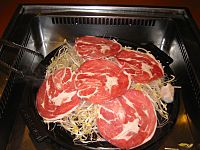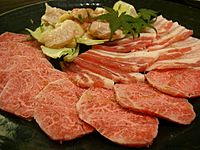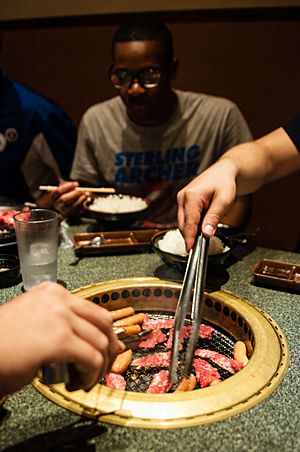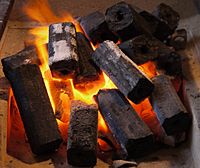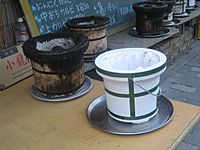Yakiniku facts for kids

Yakiniku
|
Yakiniku (焼き肉 or 焼肉) means "grilled meat" in Japanese. It's a popular Japanese way of cooking and eating meat. Imagine grilling small pieces of meat and vegetables right at your table!
This style of cooking is one of the most loved dishes in Japan. It's often compared to Korean barbecue, which is also very popular. Yakiniku restaurants usually have a grill built into the table. You order raw meat (like beef or pork) and vegetables. Then, you cook them yourself over a flame, often from charcoal or a gas grill.
After cooking, you dip the meat and veggies into special sauces called tare. A common tare sauce is made from soy sauce, sake (a Japanese rice wine), mirin (a sweet cooking wine), sugar, garlic, fruit juice, and sesame. Sometimes, people use sauces made with garlic, shallots, or miso (a fermented soybean paste).
Contents
History of Yakiniku
How Yakiniku Got Its Name
For many years, eating beef was not allowed in Japan. But in 1871, after a big change called the Meiji Restoration, it became legal. This was part of an effort to bring Western culture to Japan. Even the Emperor Meiji publicly ate beef to encourage people to try it.
The word "yakiniku" was first used in 1872 by a Japanese writer, Kanagaki Robun. He used it in his "western food handbook" to mean grilled meat, like Western barbecue. Over time, the word "yakiniku" became strongly linked to the Korean style of grilling meat.
There's also a dish called Jingisukan (Genghis Khan). It's a type of yakiniku where you grill mutton (sheep meat). This dish started in Hokkaidō, a northern part of Japan, and has become popular all over the country.
Where Yakiniku Comes From
The way we eat yakiniku today, with its strong links to Korean dishes like bulgogi and galbi, became popular in Japan after World War II. Many Korean restaurants opened in cities like Osaka and Tokyo around 1945. These restaurants served grilled meat dishes.
At first, these restaurants might have called their food "Korean cuisine" (Chōsen ryōri). But later, due to political changes, some businesses started using "Kankoku ryōri" (named after South Korea). To avoid confusion and political arguments, the term "yakiniku" became a common and neutral way to describe these grilled meat restaurants.
In the 1980s, a company introduced special grills with built-in fans. This meant people could eat yakiniku without getting smoky, making it even more popular. Also, in 1991, beef became cheaper in Japan, which helped yakiniku become even more widespread.
What's in Yakiniku?
Yakiniku uses many different ingredients. Here are some common ones:
- Beef:
- Rōsu — Slices from the loin and shoulder.
- Karubi — Short ribs, often served without bones. This name comes from the Korean word "galbi."
- Harami — Tender meat from around the diaphragm.
- Tan — Beef tongue. It's often served with salt, lemon juice, and chopped green onions.
- Misuji — Tender meat from around the shoulder.
- Pork:
- Butabara or Samugyopusaru — Pork belly.
- P-toro / Tontoro — Fatty meat from the cheek and neck.
- Horumon or Motsu — These terms refer to offal, which are parts of the animal that are not muscle meat. "Horumon" means "discarded items" in a local Japanese dialect.
- Chicken
- Seafood: You can also grill squid, shellfish, and shrimp.
- Vegetables: Many different vegetables are grilled, such as bell peppers, carrots, shiitake mushrooms, other types of mushrooms, onions, cabbage, eggplant, bean sprouts (moyashi), garlic, and kabocha squash.
Yakiniku Day
In 1993, the All Japan Yakiniku Association declared August 29th as official "Yakiniku Day." This is a fun play on words in Japanese. The numbers 8 (ya), 2 (ni), and 9 (ku) sound like "yakiniku" when put together!
See also
 In Spanish: Yakiniku para niños
In Spanish: Yakiniku para niños



